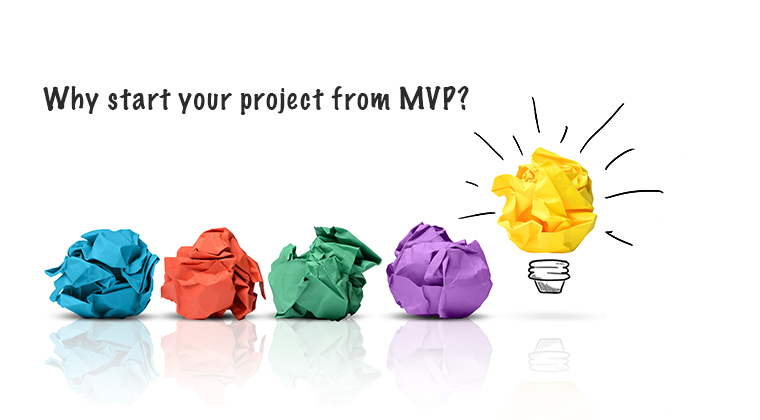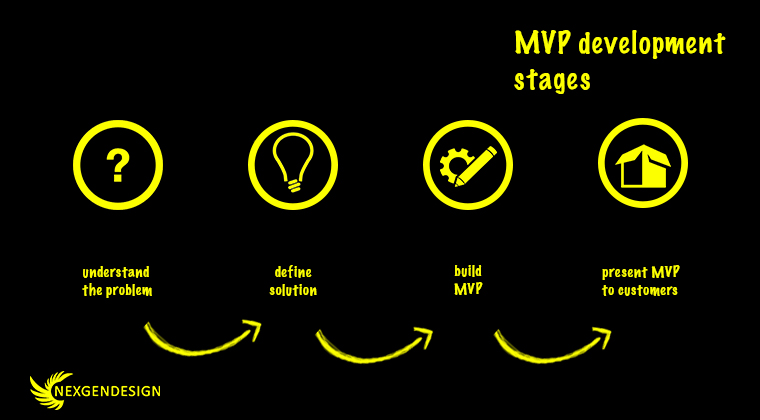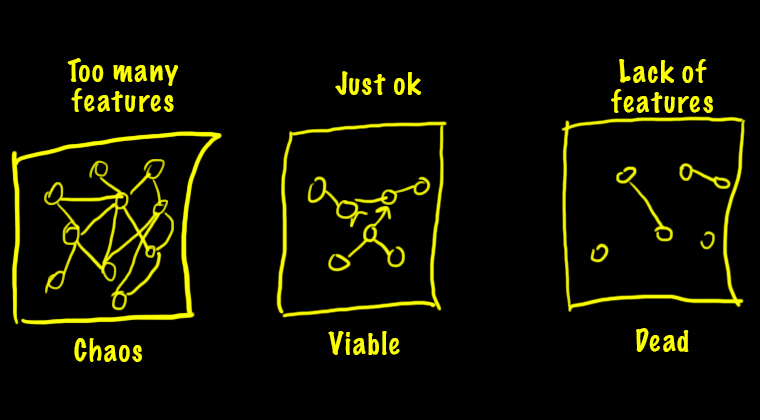
What is MVP?
In software development, MVP frequently appears in the context of risk reduction and highest investment returns. In a nutshell, minimum viable product (or MVP) is a product version that has limited set of core features that allow to get general understanding of and learning about the future product. It is a minimalistic set of functions that help developers reach their first clients and receive first money. Because of immediate customer feedback, it helps to accomplish the initial goals of a product.
How did MVP appear
In 2001, SyncDev CEO, Frank Robinson, questioned the usual process of “design, build, sell.” He created a model that made customers reveal their desires before developers began developing product design actually. In recent years, popularity of MVP development has risen after Eric Ries insisted on its advantages in his book Lean Startup. With the efforts of all its promoters, MVP product development goes beyond the limits of a version creation. Now, it refers to the whole mindset that stands on “Think big for the long term and small for the short term” thesis, meaning concentration on the core idea before developing the enhanced project in a long-term perspective.
Why we need MVP?
In the blog post about the hidden costs of mobile app development, we mention MVP as a helpful tool for checking the app idea before starting its in-depth development. In this case, MVP is useful not only for customers but also for vendors in terms of confidence and return on risk. In this context, product developers can immediately react to the market feedback with releasing iterations. At the same time, MVP development has the intention to create customer fans or product evangelists, who assist in product promotion within the market.
The main MVP development stages

- Understanding the problem of potential customers. The overall idea of MVP development is to create the product for individual early adopters that have one common problem. While starting to develop MVP, it is crucial to address only the core problems, but not everything at once.
- Finding the smallest possible MVP solution. In the MVP design, the ‘minimal’ part refers to finding out the least complicated idea that solves your customer’s problem. This solution turns into a basic idea that attracts potential clients with the problem identified in the first stage.
- Developing MVP. You should include additional features that refer to your new customers with the specific requirements for the same problem. In this context, the number of features must be just enough to resonate with the needs of early adopters.
- MVP presentation to early visionary customers. Now MVP reaches its first customer audience (early adopters). At this stage, the product version should refer to its potential clients who acknowledge the problem identified in the initial steps of MVP development and strive to solve it. Based on the collected feedback,developers can see the priority list of features they can implement quickly in the future product.
Alternatives to MVP

As it is evident from the idea of MVP, it has the ambitious goal to convince customers to buy the product by seeing the minimum set of its features. However, founders mostly refer to alternative methods of product development. Here we refer to the most common options that may replace the key stages of MVP.
Market research
Both MVP and market research acknowledge the importance of market investigation before launching the new product. Thus, this alternative does not conflict with the MVP idea. At the same time, market research analyzes overall market and helps to comprehend the target market. Along with the early adopters, it identifies the target customers who do not search for solution to the same problem. In its turn, MVP is a customer development tactic that concentrates on users who have only the identified problem.
Win-loss analysis
As another option of market understanding, the win-loss analysis shows the impressions of customers on a particular product. It helps to understand the positioning of your product on the market. Thus, the aim of this alternative is to reach potential buyers from the whole market, but not to get the reaction of early adopters. At the same time, MVP development can include win-loss analysis in its framework as the validation technique of the presented solution. In this context, the win-loss analysis is useful to collect customers’ feedback on the delivered MVP.
Beta project versions
While learning about MVP, one can easily twist it up with the beta version. However, MVP is not the first product release. Here, the beta version deals with full functionality and established product experience. This alternative is useful for accurate understanding of market problems and needs, while MVP idea helps to share your vision with customers and not to present the outline of set application. In this context, the MVP design rather concentrates on your customers’ feedback than building a simple model of a future product.
Which products need MVP?

As it turns from the MVP approach, almost every product that raises doubt regarding design and customer expectations fits this development model. Although, MVP development reveals itself as a time-consuming process. In this case, fast implementation of a product negates advantages of MVP. Since it needs continued feedback collection and release iterations, strict deadlines will not allow gaining benefits from MVP development. Here’re the three basic project types we highly recommend to start from having an MVP:
- For-profit businesses
Start-ups frequently rely on MVP development. Because of the resource scarcity, newcomers use this instrument to solve problems of their potential customers. For example, Kickstarter shows that presentation of the core functionality helps in launching for-profit business. With the help of MVP, businesses can understand their customers’ readiness to pay for the whole application.
- Non-profit
MVP development is useful for crowdfunding organizations. Such projects use this model to provide general idea and attract early adopters to invest in them. For example, Digital Frontier Institute launched MVP development in order to access their market fast and check the ability of their audience to donate.
- Projects divided into several parts
Projects under MVP development are frequently divided into several parts to introduce customers certain functions. In this case, most of the contemporary successful social networks (like Linkedin, Instagram, and Twitter) used MVP at the beginning. As for Twitter, their vendors initiated the project as a digital replacement of SMS messaging. After their customer feedback was in, they developed the website and added the function of the news platform. Thus, MVP development is highly useful when it is challenging for startuppers to determine the appearance of their product.
Benefits of outsourced MVP

Since the idea of outsourcing is popular in the contemporary software world, this topic inevitably appears in the context of MVP development. In this case, the rewarding potential of outsourcing not only works but also empowers the key MVP strengths mentioned here. Here, we refer to the benefits of the outsourced MVP development in terms of costs, risks and staff management.
Opportunity to receive customer feedback and reduce operational expenses
As a model that increases learning and shortens development costs, MVP contributes to the decreasing of the expenditures. In particular, it gives the word to customers, minimizing the risk of doing the unnecessary job while making a product. In other words, MVP provides an opportunity to bring some necessary changes that customers articulate at the early stage. Since developers know the expectations of potential clients, they do not work intensively on useless features they change after launching an app. In this case, outsourcing helps to cut the operational costs, meaning tech team management and communal spending (like staff training or corporate events). Hence, the outsourced MVP development helps to reduce the costs of creating a product, meaning both the amount of work done and the working environment in which it operates.
Reaching potential customers at the early stage
In order to reduce the risks of investing extra resources, both MVP development and outsourcing consider easy access to clients as the core element of getting the job done. Incase of MVP, the product version changes under the feedback received from early adopters. This approach helps to reach customers’ desires directly before bringing changes to the product. As a result, developers know the reaction to the product they work on at the very beginning. Moreover, outsourcing with its emphasis on easy access to the stakeholders regardless their location guarantees reaching both potential customers and professional developers. Therefore, the process of creating your final product is accurate to the needs of the target market, less risky, and easier to arrange.
Review all features to concentrate on the necessary ones
In case of MVP development, the initial goal for communication with customers is to change the product. Thus, this method helps to reveal the priority of features presented in a product. Based on feedback from your customers, MVP development gives reasons to preferencing, abandoning or adding new features to your product. Here, the opportunities of outsourcing offer a vast amount of professional stuff to bring the necessary changes. In case of unexpected feedback from early adopters, the choice to outsource helps the team to react to the market’s feedback accurately and change the product earlier. Thus, outsourced MVP development makes it possible to concentrate on the core features in the most effective manner.
As we see, MVP development is a useful technique to clarify the expectations of target customers. It helps to establish the basic model of the further product. Moreover, it offers customers to determine its future details. To increase the potential benefits of MVP development, we encourage doing outsourcing to make the process cheaper, less risky, flexible, and professional.
Feel confident to develop your product’s MVP to deliver the best experience to your customers!





